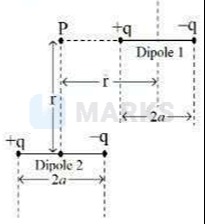Question
Question: The provided image shows two electric dipoles and a point P. Determine the electric potential at poi...
The provided image shows two electric dipoles and a point P. Determine the electric potential at point P.

4πϵ012r2aq
−4πϵ012r2aq
0
4πϵ01r2aq
−4πϵ012r2aq
Solution
The problem involves calculating the electric potential at point P due to two electric dipoles. We set up a coordinate system with the center of Dipole 2 at the origin (0,0).
-
Dipole 2: The charges are at (a,0) and (-a,0). Point P is at (0, r). The electric potential at a point on the perpendicular bisector of a dipole is zero. Using the dipole approximation V=4πϵ01R3p⋅R for R≫a, where p=2aqi^ and R=rj^, we get V2=0.
-
Dipole 1: The center of Dipole 1 is at a horizontal distance 'r' from the origin and a vertical distance 'r' from point P. This leads to two possible locations for the center of Dipole 1: (r, 0) or (r, 2r).
- If the center is at (r, 0), p1=2aqi^ and R1=(−r,r). Then V1≈4πϵ01(r2)3(2aqi^)⋅(−ri^+rj^)=4πϵ0122r3−2aqr=4πϵ012r2−aq.
- If the center is at (r, 2r), p1=2aqi^ and R1=(−r,−r). Then V1≈4πϵ01(r2)3(2aqi^)⋅(−ri^−rj^)=4πϵ0122r3−2aqr=4πϵ012r2−aq.
-
Total Potential: The total potential at P is V=V1+V2=V1+0=−4πϵ012r2aq.
